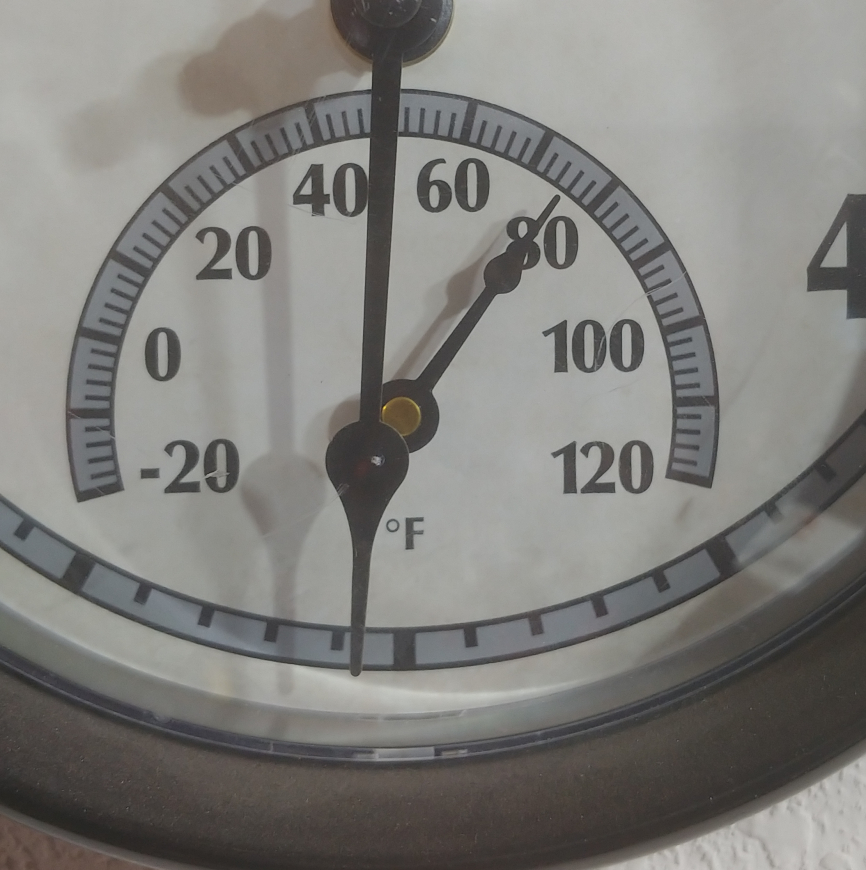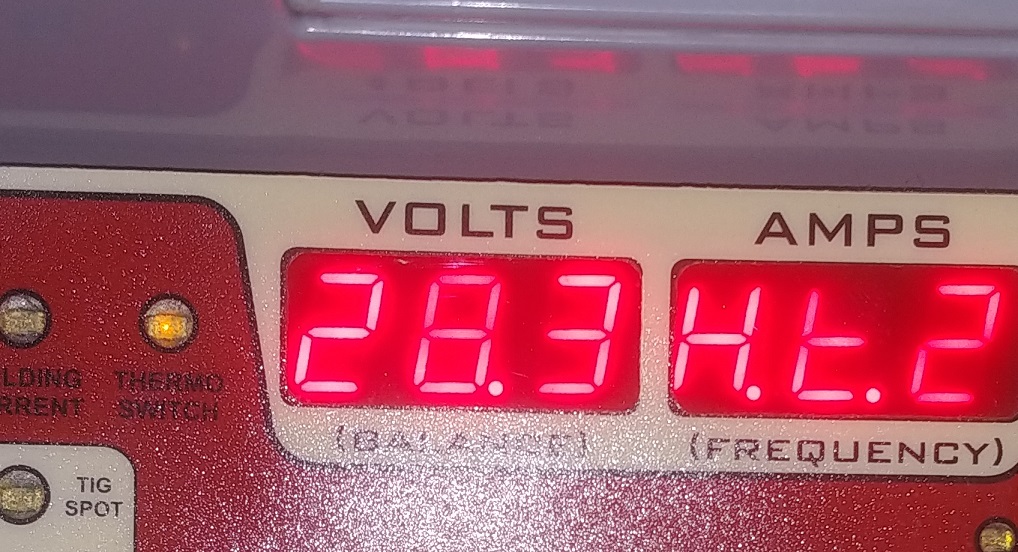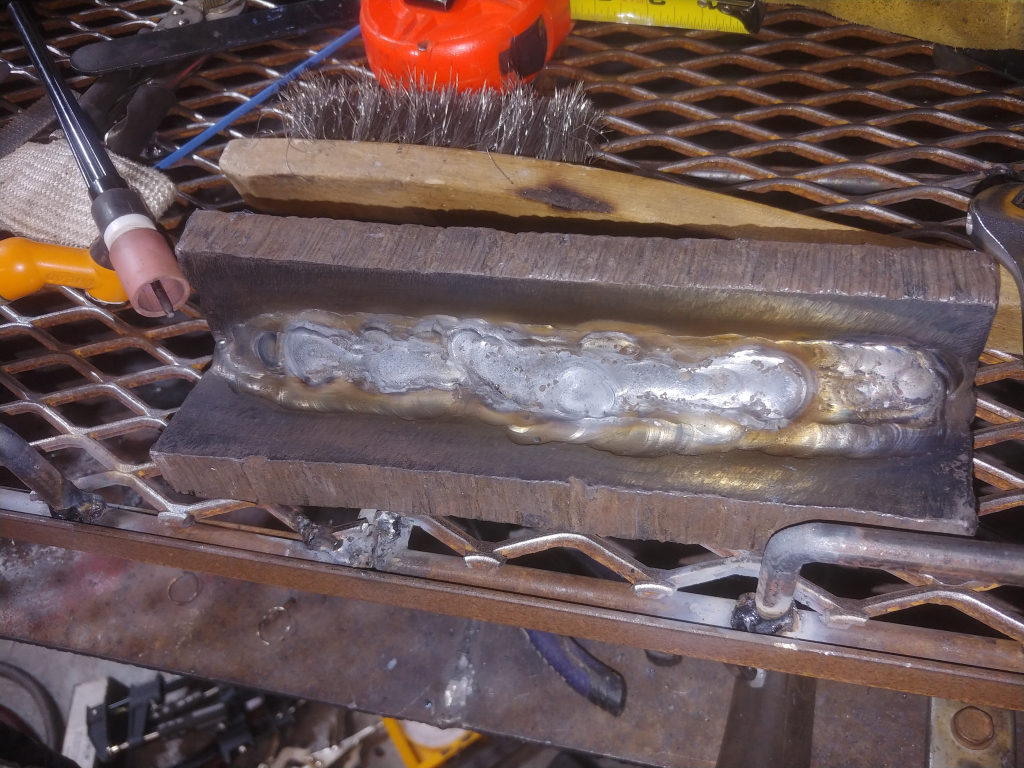So a FlyFishing piqued my curiosity as to what the "real world" thermal limits are on my Invertig 221. By "real world" I don't mean worst-case scenario, but rather what the machine would experience in an average shop.
This was rather impromptu, so I don't have video footage (yet), but the data I'm presenting is factual.
Ambient temperature:

Picture showing machine at thermal overload:

test piece to absorb a lot of heat:

Machine showed 217A on the display. Not sure why not 220A, never really payed attention to it, perhaps just production tolerances.
Time until thermal over-load/shut-down (minutes:seconds):
1st & 2nd done back-to-back, 3rd-5th back-to-back, meaning as soon as the thermal overload light turned off I went back at it at full power.
1st: 4:32
2nd: 3:38
3rd: 3:20
4th: 3:02
5th: 2:51
Those time durations for arc on-time aren't all that surprising seeing as how the machine is rated at 20% duty cycle @ 220A @ 104°F, and the ambient temp was well below that.
BUT...........
I initially "felt" like the cool-down time (until the thermal switch turned off and I was able to strike an arc again) was in the neighborhood of 5 or 6 min, but I wasn't paying too much attention to that part; I was more focused on how long the arc was on. But as I did more and more of those over-loads, I started to pay more and more attention to just how long it actually took to restore itself back to full operation. After the last thermal overload duration of 2:51, I let the stopwatch on my phone keep going to then subtract the time and see just how long it takes to recover so one can get back to welding. Shockingly, the thermal light turned off at 6:30! Subtract the 2:51 that the machine actually had the arc on, and that means that it only took 3:39 to cool down!
So if you go back to the 4th thermal overload, I had the arc on for 3:02, machine cooled down for about ~3:39, and then the 5th arc duration was 2:51 before it overloaded again; that's a total of 9:32. At 9:32 it was overloaded (and would have stayed that way for the next few minutes), so say 10min flat, and out of those 10min, the arc was on (albeit not consecutively) for 5:53. So almost 6 minutes it was arc-on during a 10min span.
Before I jump to any conclusions, I speculated what would happen the next 10min. It would have been off for about 3min (because it was already overloaded), been able to weld for about 2:45 at the current rate of decrease, then another ~3:40 to recover, then on for maybe 30sec before the 10min span is up again. So the 2nd 10min would be about 32% duty cycle. Average that out with the 1st 10min span, and one would be looking at an average of about a 45% duty cycle (over a 20 minute span) at an ambient temperature of 75°F. Not too bad.
This was rather impromptu, so I don't have video footage (yet), but the data I'm presenting is factual.
Ambient temperature:
Picture showing machine at thermal overload:
test piece to absorb a lot of heat:
Machine showed 217A on the display. Not sure why not 220A, never really payed attention to it, perhaps just production tolerances.
Time until thermal over-load/shut-down (minutes:seconds):
1st & 2nd done back-to-back, 3rd-5th back-to-back, meaning as soon as the thermal overload light turned off I went back at it at full power.
1st: 4:32
2nd: 3:38
3rd: 3:20
4th: 3:02
5th: 2:51
Those time durations for arc on-time aren't all that surprising seeing as how the machine is rated at 20% duty cycle @ 220A @ 104°F, and the ambient temp was well below that.
BUT...........
I initially "felt" like the cool-down time (until the thermal switch turned off and I was able to strike an arc again) was in the neighborhood of 5 or 6 min, but I wasn't paying too much attention to that part; I was more focused on how long the arc was on. But as I did more and more of those over-loads, I started to pay more and more attention to just how long it actually took to restore itself back to full operation. After the last thermal overload duration of 2:51, I let the stopwatch on my phone keep going to then subtract the time and see just how long it takes to recover so one can get back to welding. Shockingly, the thermal light turned off at 6:30! Subtract the 2:51 that the machine actually had the arc on, and that means that it only took 3:39 to cool down!
So if you go back to the 4th thermal overload, I had the arc on for 3:02, machine cooled down for about ~3:39, and then the 5th arc duration was 2:51 before it overloaded again; that's a total of 9:32. At 9:32 it was overloaded (and would have stayed that way for the next few minutes), so say 10min flat, and out of those 10min, the arc was on (albeit not consecutively) for 5:53. So almost 6 minutes it was arc-on during a 10min span.
Before I jump to any conclusions, I speculated what would happen the next 10min. It would have been off for about 3min (because it was already overloaded), been able to weld for about 2:45 at the current rate of decrease, then another ~3:40 to recover, then on for maybe 30sec before the 10min span is up again. So the 2nd 10min would be about 32% duty cycle. Average that out with the 1st 10min span, and one would be looking at an average of about a 45% duty cycle (over a 20 minute span) at an ambient temperature of 75°F. Not too bad.

